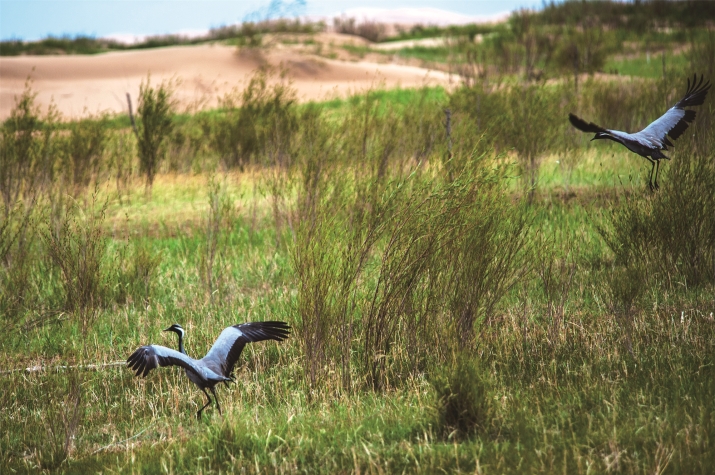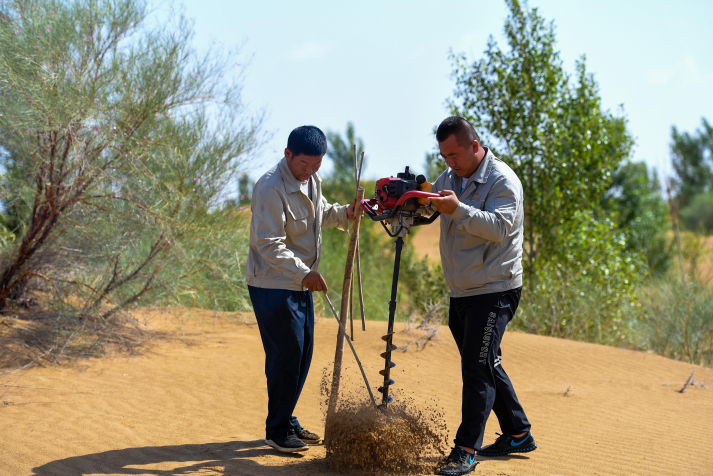|
||||||||||
| Home Nation World Business Opinion Lifestyle ChinAfrica Multimedia Columnists Documents Special Reports |
|
||||||||||
| Home Nation World Business Opinion Lifestyle ChinAfrica Multimedia Columnists Documents Special Reports |
| Current Cover Story |
| Maintaining a Balance |
| China's desert communities promote viable and sustainable approach to desertification control |
| By Li Xiaoyu | VOL.11 June ·2019-05-29 |

Ecological system is gradually restored in Kubuqi (COURTESY)
Li Long is a 39-year-old doctor in Beijing. He still remembers sandstorms ravaging the Chinese capital during spring when he was a university student about 20 years ago.
"On the streets everyone had to wear a mask or a scarf to cover their noses and mouths. The sand was not only a menace outside, but it also blew into people's houses. One of the biggest hazards was that it disturbed visibility which played havoc with traffic on the roads. It gave an impression of the end of the world," he recalled.
Yet, in recent years, sand and dust storms have rarely been seen in Beijing. It is no longer a major concern for local residents like Li. In the 1950s, there was an average of 56 sand or dust storms per year sweeping across the city. In 2017, that number dropped to seven.
About 800 km from Beijing is one of the three deserts causing the sandstorms. Kubuqi Desert, the seventh largest desert in China, was traditionally blasted by the Siberian winds every spring, sending sand flying toward Beijing. The decrease in the number of sandstorms in Beijing is largely due to reforestation in Kubuqi Desert.
Formerly known as a "sand pond suspended over the capital," it has seen its vegetation coverage increase from about 5 percent in the 1980s to 53 percent in 2016. The United Nations Environment Program (UN Environment) describes the region as "a global eco-economic example," whose ecological restoration project is estimated at nearly $1.8 billion. With desertification being a global scourge, the Kubuqi's transformation model is gradually attracting the attention of the international community. Globally, it is estimated that there is 36 million square km of desertification affected areas in the world, which impacts about 2 billion people.
Acting in concert
Located in the northern part of Ordos Plateau in the Inner Mongolia Autonomous Region in north China, Kubuqi Desert covers an area of 18,600 square km. Yet, 3,000 years ago, it was a forest region. With the degradation of the climate and the overexploitation of the land, the ecological system has been weakened. The once fertile fields have been transformed into a "sea of death."
"In the 1950s and the 1960s, we did not have enough to eat," Liang Changxiong, Deputy Director of the Forestry Bureau of Hanggin Banner of Ordos, told ChinAfrica.
"To ensure enough food for local residents, excessive farming was then practiced, resulting in further deterioration of the environment."
By 1988, there was an annual rainfall of less than 100 mm, less than 10 animal species lived in the area and the vegetation coverage was 3 to 5 percent. The situation was dire.
"The land has never been left fallow so nothing has grown back," said Liang. "We then realized that we could not exploit nature excessively. We had to find a balance."
From the late 1970s to the end of the 1980s, an ambitious project was initiated to build a forest belt in northwest, north and northeast China. This project is a symbol of China's environmental restoration that aims to support the fragile ecology along the belt in north China. Ordos became a part of the project.
It was also during this period that the local administration implemented an income generating and land management policy, still in force today. According to this policy, anyone who plants herbs or trees in the desert can enjoy the right to farm the land and to gain all the profits generated. The policy was an immediate hit with local residents.
One of these beneficiaries is Baiyindaoerji, a local shepherd aged 63. In 1983 he left the army and was prepared to move to the city. However, when he got wind of the new policy, he decided to return to his hometown to plant trees.
"I wanted to change my destiny with my own hands. It was a golden opportunity," he told ChinAfrica. Today, along with trees, plants such as jujube and caragana that thrive in these conditions cover the 600-hectare meadows in Baiyindaoerji's area and sandstorms or dusty conditions are a thing of the past.
Like Baiyindaoerji, many local businesses are also involved in Kubuqi's ecological restoration. The Elion Group is one of them. Founded in 1988, the company was born from a salt refinery located in the middle of Kubuqi Desert. At that time a 300-km detour was used to carry salt from the remote area of the refinery to the market. To cut down on the cost of transportation and ensure the company's survival, Elion built a new 65-km road through the desert in six months. However, a sandstorm buried the road a few days after its inauguration. To preserve this vital corridor, the company began to plant trees along the road and then, started to reforest the desert. After 30 years, thanks to this effort, an oasis of 6,000 square km covers the region.
According to a UN Environment report, the core of the Kubuqi model is the establishment of a system that integrates policy instruments, private sector investment and active participation of local people. This statement is echoed in the analysis made by Han Meifei, Chief Scientist at Elion. According to him, it would be impossible for a company to succeed alone in the reforestation of the desert without government support and participation of local people.
"For example, when Elion proposed the ecological restoration of the Kubuqi Desert, the government immediately announced a ban on grazing. The construction of the road crossing the desert was also unfeasible without the collaboration of the administration and the local inhabitants," said Han.

ELION staff plant trees in Kubuqi Desert in July 2018 (PENG YUAN)
Sustainability is key
No model of development can claim to be sustainable without respecting the laws of nature. The fight against desertification is no exception. Engaging in reforestation for more than 30 years, the deputy director of the Hanggin Forestry Bureau has a lot to say about it.
Liang still remembers the planting method adopted in the past. "We planted everything that was likely to grow green without worrying about their survival," he said. After an expansive reforestation effort, it was found that many plants had died as a result of the scarcity of water. "This failure pushed us to adopt planting strategies that took into account the availability of water," he said.
Thus, the greening of Kubuqi has made steady progress. The northern end of the desert is dotted with large trees to stop the progression of the sands to the north. On the other hand, in the middle of the desert are shrubs, which are more water-efficient. The construction of roads crossing the desert facilitates management of the reforestation efforts in its entirety.
Planting-in-sand methods have also been adjusted gradually for maximum effect. Today, trees are only planted on the slopes of the dunes exposed to the wind and up to three quarters of their height, which lets the wind carry the sand from the top to the bottom of the trunk. With time, the summit of the dune is gradually reduced by the wind and the loss of sand is fixed in place by the tree roots. "This technique is more efficient and less expensive than the old method where we planted grass, maize stalks and reeds on all the slopes of the dunes," said Han.
Always aiming at preserving the sustainability of its model, local government now places greater importance on the balance between ecological restoration, economic growth and the improvement of the well-being of the population. "At first, we only focused on the ecological aspect of reforestation. But if people could not earn a living and have more profits, their enthusiasm would eventually be exhausted," said Liang.
For example, residents and businesses have been encouraged to plant cash crops, such as licorice. This is not only an important medicinal plant of traditional Chinese medicine, but it also helps introduce nitrogen into the soil, thus improving soil quality. Thanks to the plantation of licorice, the desert can be transformed into organic soil on a large scale, which has made it possible to develop a desert-specific agriculture, such as the cultivation of watermelons and tomatoes, among others.
Baiyindaoerji has been growing licorice for over 10 years. The plant has helped him pay off debt of 670,000 yuan ($98,000) and he now has an annual income of more than 200,000 yuan ($29,500). But he wants to harvest only a few licorice plants a year.
"I want my plants to be sustainable. My method is to maintain a balance between ecological protection and the accumulation of wealth," he said.
Internationally recognized model
Clearly, China's efforts to combat desertification go far beyond the reforestation of the Kubuqi Desert. China's desert land area is shrinking by more than 2,400 square km each year, compared with an average annual expansion of more than 10,000 square km at the end of the last century. This makes China the first country in the world to achieve a retreat in desertification, according to statistics from the National Forestry and Grassland Administration. For the 2016-20 period, the country aims to rehabilitate 10 million hectares of desert and to transform this into green areas.
These efforts are recognized by the international community. As evidenced by a study published in February by NASA, China has been one of the main contributors to the greening of the Earth between 2000 and 2017, contributing at least 25 percent.
On the occasion of the third edition of the United Nations Environment Assembly held in December 2017 in Nairobi, Wang Wenbiao, President of Elion, was awarded the "Champion of the Earth" for his commitment to the transformation of deserts into oases. For its part, the Chinese afforestation community of Saihanba in Hebei Province also won the prestigious United Nations award.
Saihanba is today a vast forest covering an area of about 750 square km. It was a barren piece of land nearly 60 years ago, but hard work for decades has made it an important ecological shield for Beijing and Tianjin.
Erik Solheim, former Executive Director of UN Environment, praised the Saihanba community not only for their pioneering and innovative work, but also for their profitable efforts in restoring a degraded environment. In addition, he also acknowledged that the Kubuqi model was a valuable experience for other countries and regions suffering from desertification, adding that such an experience should extend to the countries of the Belt and Road Initiative for their own benefit.
(Comments to lixiaoyu@chinafrica.cn)
| About Us | Contact Us | Advertise with Us | Subscribe |
| Copyright Beijing Review All rights reserved 京ICP备08005356号-5 京公网安备110102005860号 |